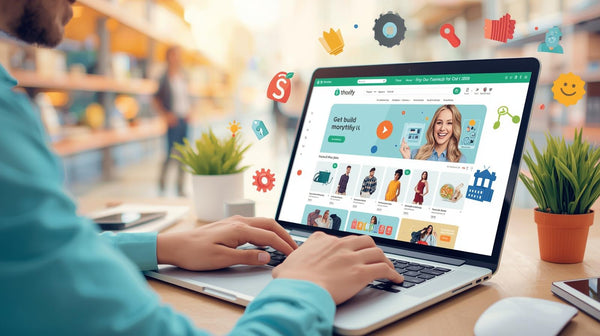WooCommerce to Shopify: Why and How to Make the Switch
Thinking about moving your eCommerce store from WooCommerce to Shopify? You’re not alone. Thousands of merchants are making the switch every year and for good reason.
While WooCommerce has long been a popular choice for WordPress users, it often comes with complex maintenance, plugin overload, and scaling limitations. Shopify, on the other hand, offers an all-in-one, user-friendly platform that’s built for growth, speed, and long-term success.
In this comprehensive guide, we’ll walk you through everything you need to know about making the switch from why it makes sense, to how the migration process works, to what challenges you should expect (and how to avoid them). Most importantly, we’ll show you how EcomSpiders, your trusted Shopify migration partner, can help make the process smooth, secure, and 100% customized to your store’s goals.
Whether you’re frustrated with WooCommerce performance issues, tired of plugin conflicts, or simply ready to scale with confidence this guide will help you decide if it’s time to move forward, and how to do it right.

Why Consider Switching from WooCommerce to Shopify?
If you’ve been running your store on WooCommerce, you’ve likely dealt with plugin updates, compatibility issues, and the constant need for technical maintenance. While WooCommerce is flexible, it often demands a lot of your time and technical attention especially as your business grows.
Switching to Shopify means fewer headaches, faster performance, and a platform built specifically for eCommerce from the ground up. Let’s break down the key reasons why this move makes sense for modern online retailers:
1. Ease of Use: No More Tech Headaches
Shopify was designed to be simple even for store owners without any coding or web development background.
-
Clean, intuitive dashboard that makes it easy to manage products, orders, and customers in one place
-
No need to manually install and configure a dozen plugins just to get basic functionality
-
Built-in features like SEO tools, analytics, and email notifications make running your store much smoother
-
Drag-and-drop design options let you customize your store without hiring a developer
For busy entrepreneurs, this simplicity means more time spent on growing your business and less time troubleshooting.
2. Enhanced Performance: Speed That Scales
When it comes to page speed and uptime, Shopify consistently outperforms WooCommerce.
-
Shopify’s cloud infrastructure is optimized for high traffic and large product catalogs
-
Pages load faster out of the box, which helps reduce bounce rates and boost conversions
-
Built-in global CDN (Content Delivery Network) ensures that your site loads quickly for customers anywhere in the world
-
Hosting, security, and caching are all handled by Shopify no configuration needed
In short: Shopify just works, even when your business starts scaling fast.
3. Comprehensive Ecosystem: Everything You Need, Already Built
Shopify offers a complete, tightly integrated ecosystem designed for eCommerce success.
-
100+ professionally designed themes that are responsive and conversion-focused
-
Over 7,000 vetted apps for everything from loyalty programs to product reviews to live chat
-
Features like abandoned cart recovery, gift cards, multi-currency support, and automatic tax calculations are built in or easy to add
-
Seamless integrations with social platforms, marketplaces, and POS systems
You don’t need to cobble together tools like on WooCommerce Shopify brings it all under one roof.
4. Reliable Support: Help When You Need It
One major pain point for WooCommerce users is figuring out who to contact when something breaks. Not so with Shopify.
-
24/7 live support via chat, phone, or email even on weekends and holidays
-
Massive knowledge base filled with tutorials, videos, and walkthroughs
-
Active community forums and a global network of Shopify Experts (like us at EcomSpiders) ready to help
You won’t be left hanging when something urgent comes up.

5. Simplified Maintenance: Focus on Growth, Not Updates
Unlike WooCommerce, which requires constant maintenance, Shopify handles all the backend work for you.
-
No need to manage server updates, theme/plugin compatibility, or security patches
-
Automatic backups and updates keep your store secure and current without lifting a finger
-
Shopify handles PCI compliance, SSL certification, and fraud protection by default
-
You don’t need to worry about hosting renewals or site speed audits
That means less time on upkeep and more time on marketing, sales, and strategy.
How to Migrate from WooCommerce to Shopify
A Practical, Step-by-Step Guide
Switching platforms doesn’t have to be complicated but it does need to be well-planned. Migrating from WooCommerce to Shopify involves a mix of technical and strategic tasks, and doing it right helps you avoid data loss, SEO issues, and downtime.
Here’s a complete breakdown of how to make the move the smart way:
1. Preparation: Lay the Groundwork
Before anything else, take time to prepare.
-
Define your goals: Are you looking to improve speed, simplify management, or rebrand entirely? Knowing this upfront shapes your migration strategy.
-
List what you’re migrating: Products, customers, past orders, categories, content, reviews, and SEO metadata.
-
Backup everything: Use a backup plugin or hosting service to secure a full backup of your WooCommerce site including the database, media, and theme files.
-
Choose your Shopify plan: Start with the right plan based on your product range, sales volume, and required features (e.g. Shopify Basic vs Advanced Shopify).
2. Export Your Data: Get Everything Ready to Move
WooCommerce stores everything in WordPress and its database, so exporting your data cleanly is key.
-
Products, customers, and orders: Use built-in WooCommerce tools or a plugin to export them in CSV format.
-
Additional content: Consider manually saving blog posts, pages, and media files.
-
SEO data and redirects: Record all important URLs and metadata for later use.
Pro Tip: Double-check your exported data especially SKU integrity and customer emails to avoid mismatches later.

3. Set Up Your Shopify Store: Build the Foundation
Now it’s time to get your new home ready.
-
Choose a theme that fits your brand (free or premium).
-
Customize your storefront with logos, colors, navigation menus, and homepage design.
-
Configure essential settings like payment providers, tax settings, and shipping zones.
-
Create foundational pages like About, Contact, FAQ, Return Policy, and Privacy Policy.
This step is where Shopify really shines—you’ll likely find setup much quicker than on WordPress.
4. Import Data to Shopify: Time to Transfer
This is where your WooCommerce data enters Shopify.
-
Use Shopify’s native import tool (under Settings > Import) or opt for a specialized app like LitExtension or Matrixify for large or complex stores.
-
Validate imported data: Double-check product listings, images, prices, and customer details.
-
Fix inconsistencies early: Missing variants or tax settings? Clean them up before launch.
Don’t forget to organize products into collections and set up navigation menus accordingly.
5. Install Apps and Features: Unlock Shopify’s Potential
Once your data is in, it’s time to customize the store for your business needs.
-
SEO tools like Smart SEO or JSON-LD for better visibility.
-
Marketing apps for email campaigns, loyalty programs, or social media integrations.
-
Analytics tools to track behavior, conversions, and traffic sources.
-
Multi-channel selling setups for Facebook, Instagram, Amazon, and more.
Remember: Shopify’s App Store is curated, so the tools are more stable and easier to use than most WordPress plugins.
6. Test Everything: Don’t Skip This
A test run is crucial before your store goes live.
-
Go through the checkout process like a real customer test different payment and shipping options.
-
Test responsiveness on desktop, tablet, and mobile devices.
-
Check page speed using tools like Google PageSpeed Insights or GTmetrix.
-
Verify functionality: Search, filters, cart, and any third-party app features.
Run a soft launch internally or with a small group of trusted customers for feedback.

7. Launch and Redirects: Go Live Without Losing SEO
When everything is tested and polished, it’s time to hit the switch.
-
Update your domain DNS to point to Shopify.
-
Use 301 redirects for all important URLs from WooCommerce so you don’t lose your SEO rankings. Shopify allows you to create custom URL redirects under “Navigation > URL Redirects.”
-
Submit your new sitemap to Google Search Console and Bing Webmaster Tools.
-
Monitor analytics closely in the first few weeks to catch any traffic drops, broken links, or unexpected behavior.
Potential Challenges When Migrating from WooCommerce to Shopify
Switching platforms is a big move and while Shopify makes the post-migration experience smoother, the transition process itself does come with a few hurdles. Here’s what to watch out for and how to plan ahead.
1. Data Mapping Complexities
Transferring your product, customer, and order data from WooCommerce to Shopify isn’t always plug-and-play. Data formats don’t always align perfectly.
-
Product variants, SKUs, tags, and categories might need manual reorganization
-
Order histories and customer profiles may require clean-up post-import
-
Custom fields or plugins on WooCommerce might not transfer directly
Pro tip: Use automated migration tools carefully and always validate imported data for accuracy.
2. Design & Theme Differences
Shopify uses a completely different theming system than WordPress + WooCommerce. This means your exact site layout and design may not carry over.
-
Some WooCommerce themes don’t have an equivalent in Shopify
-
Rebuilding your brand’s visual identity might take more time than expected
-
UX (user experience) adjustments might be needed for navigation or mobile responsiveness
But here's the silver lining this can be a great opportunity to upgrade your design and optimize for conversions.

3. Feature Replacements & Plugin Gaps
WooCommerce relies heavily on plugins, some of which may not exist in the Shopify ecosystem or work differently.
-
Some advanced customizations might require paid Shopify apps
-
Plugin-based workflows on WooCommerce may need rethinking
-
Subscription services, booking systems, or unique checkout flows might require rebuilding
At EcomSpiders, we help map out your plugin setup and find efficient Shopify-native or third-party solutions that preserve your functionality or improve it.
4. SEO Considerations
One of the most overlooked challenges is how your site’s SEO might be affected during migration.
-
Page URLs may change, which can break backlinks
-
Meta titles, descriptions, and schema data need to be retained
-
Improper redirects can cause temporary drops in traffic
Solution: Implement 301 redirects, submit updated sitemaps, and monitor traffic using Search Console post-launch.
5. Team Adaptation and Workflow Changes
Even though Shopify is intuitive, your team may need time to adapt if they’ve been using WooCommerce for years.
-
Admin panel layout and feature access are different
-
Learning how to manage orders, apps, and themes on Shopify takes a bit of ramp-up
-
Training staff on the new system can slow down operations temporarily
Luckily, Shopify’s documentation is robust and agencies like EcomSpiders provide training as part of the migration package.
6. Budget Planning
Migrations are an investment. While Shopify simplifies hosting, security, and performance there are costs to consider.
-
Subscription plans (Shopify charges monthly)
-
Paid themes or apps to match WooCommerce capabilities
-
One-time migration or design service fees
The ROI is usually worth it but plan ahead to avoid unexpected expenses.

7. Third-Party Integration Compatibility
If your business relies on ERP, CRM, or inventory systems, not all integrations may seamlessly carry over.
-
Some systems might require custom API development
-
Shopify may offer alternatives that need testing
-
Workflow automation tools (like Zapier or Make) might need reconfiguration
How EcomSpiders Can Help with WooCommerce to Shopify Migration
At EcomSpiders, we don’t just migrate your store we elevate it. Our team brings 7+ years of Shopify experience, a deep understanding of WooCommerce systems, and a proven framework for smooth, efficient transitions that preserve your brand identity, customer trust, and SEO power.
Here's how we make your move from WooCommerce to Shopify a seamless success:
1. End-to-End Data Migration
We take care of the technical heavy lifting so you don’t lose a single product, customer, or order.
-
Complete migration of products, categories, customer accounts, and order history
-
Secure transfer of metadata, tags, variants, images, and SKUs
-
Post-migration validation to ensure accuracy and integrity of all records
-
Backup and fallback plans to prevent data loss
2. Custom Shopify Store Design
Your store isn’t just a template it’s your brand. We design it to feel that way.
-
Bespoke Shopify themes tailored to your visual identity
-
Mobile-first design with a focus on speed, UX, and conversion flow
-
Design upgrades that reflect current best practices and brand consistency
-
Redesign opportunity to modernize or refresh your storefront
3. App Integration & Workflow Automation
WooCommerce plugins don’t always translate directly so we replace and upgrade where needed.
-
App audit to match and improve your existing functionality
-
Integration with leading Shopify apps for reviews, marketing, subscriptions, and more
-
Automation setup using tools like Klaviyo, Omnisend, Zapier, Make.com, etc.
-
Optimization of post-purchase flows and customer retention systems

4. Performance Optimization
Speed sells. We make sure your new Shopify store performs at its peak.
-
Lightning-fast load times and mobile responsiveness
-
Image compression, script optimization, and caching setup
-
Technical audits to remove friction from the buyer journey
-
Accessibility and Core Web Vitals compliance for SEO benefits
5. SEO Preservation & Strategy
We protect your existing rankings and build a stronger SEO foundation on Shopify.
-
URL redirects to prevent broken links and loss of organic traffic
-
Metadata, schema, and content structure optimization
-
SEO audits before and after migration
-
Content migration and keyword targeting strategies
-
Shopify blog integration with a custom SEO-focused editorial plan
6. Digital Marketing Execution
Let’s get real migration is just the beginning. Growth is the goal.
-
Paid ads, email flows, and social campaigns tailored to Shopify
-
Analytics-driven campaign strategy using UTM tagging and conversion tracking
-
Integration with Meta, Google Ads, TikTok, and influencer marketing tools
-
A/B testing and CRO (Conversion Rate Optimization) implementation
7. Ongoing Support & Growth Partnership
We don’t disappear after launch. We scale with you.
-
Real-time support via Slack, WhatsApp, or email
-
Monthly maintenance, security checks, and updates
-
Bug fixes, theme tweaks, and app troubleshooting
-
Dedicated account manager for larger projects

8. Advanced Reporting & Analytics
We turn your data into insights that drive revenue.
-
Shopify Analytics setup + Google Analytics 4 configuration
-
Sales funnels, customer lifetime value, and attribution tracking
-
Custom dashboard builds using tools like Looker Studio or Triple Whale
-
KPI-based reports delivered monthly or quarterly
9. Custom Development & Private Apps
Need something unique? We build what others can’t.
-
Tailored features, backend logic, and Shopify Functions
-
Custom storefronts using Hydrogen + Oxygen (Shopify’s headless framework)
-
Private apps for integrations with CRMs, ERPs, or fulfillment platforms
-
API-based automation for complex business operations
10. Content Strategy & Blog Optimization
Content is still king especially for SEO.
-
Migration of existing blog content to Shopify
-
SEO-optimized post formatting and internal linking
-
Strategic content planning for authority and keyword targeting
-
Blog design aligned with brand voice and readability
Bonus Tips for a Smooth WooCommerce to Shopify Migration
Switching from WooCommerce to Shopify isn’t just about transferring data it’s about doing it right. A rushed or messy migration can lead to downtime, broken URLs, or even lost rankings. Here are 10 pro-level tips from our migration experts at EcomSpiders to help ensure a flawless transition:

1. Clean Your Data Before Export
Before anything gets transferred, go through your WooCommerce store and:
-
Remove outdated or duplicate products
-
Delete spam customer accounts
-
Archive old orders you no longer need
This helps reduce clutter and speeds up the migration process.
2. Audit Your URLs and Set Up 301 Redirects
If your Shopify URLs differ from your WooCommerce ones (which they often do), set up 301 redirects for all major pages:
-
Homepage
-
Product pages
-
Category/collection pages
-
Blog posts
This preserves your SEO juice and avoids 404 errors.
3. Review and Resize Product Images
Shopify uses specific image guidelines for best display across devices. Before uploading:
-
Compress and optimize images (without losing quality)
-
Ensure consistent dimensions for product images
-
Use descriptive filenames for better SEO
4. Map Out Your Shopify Navigation Early
Plan your menus and collections before importing. This helps:
-
Keep your store structure organized
-
Make the setup quicker post-import
-
Improve user navigation and conversion rates

5. Test the Migration in a Staging Store
Always use a Shopify development store (or a duplicate) to:
-
Test how your products, customers, and orders display
-
Check if plugins or apps are working properly
-
Fix layout/design issues before going live
6. Check Shopify App Compatibility
Some WooCommerce plugins may not have a direct Shopify equivalent. Make a list of your essential features (e.g., subscriptions, product bundles, rewards) and consult the Shopify App Store or a developer for:
-
Equivalent or better apps
-
Custom integrations if needed
7. Don’t Forget Tax and Shipping Settings
These often get overlooked. Double-check your:
-
Shipping zones and rates
-
Tax rules and exemptions
-
Checkout configurations (especially for international sellers)
8. Optimize Store Speed Before Launch
Even if Shopify is inherently faster, bloated images, unoptimized themes, or too many apps can slow it down. Before launch:
-
Run speed tests (Google PageSpeed, GTmetrix)
-
Minimize app usage
-
Choose a lightweight, responsive theme
9. Retain Important Metadata
Ensure that product meta titles, descriptions, and alt text are correctly transferred or manually recreated. This is vital for:
-
SEO rankings
-
Accessibility
-
Image search visibility
10. Post-Migration Checklist
Once you go live, run through this quick QA:
-
Do all redirects work?
-
Are product variants displaying correctly?
-
Is checkout working flawlessly?
-
Are analytics and Facebook Pixel tracking properly?
-
Is your domain connected and SSL active?

Final Thoughts: Ready for a Smarter E-Commerce Future?
Migrating from WooCommerce to Shopify isn’t just about changing platforms it’s about unlocking new potential for your brand.
Shopify offers a faster, more scalable, and conversion-focused environment that empowers store owners to streamline operations, boost sales, and scale without the technical headaches of traditional platforms. Whether you're looking to simplify your backend, increase mobile performance, or tap into powerful marketing tools Shopify makes it possible.
But to get the most out of this move, you need the right migration partner and that’s where we come in.
Why Choose EcomSpiders?
We’re not just another web agency we’re Shopify specialists who live and breathe e-commerce growth. Our mission is to make your migration feel effortless, your new store look amazing, and your business scale faster than ever before.
Here’s what sets us apart:
-
Proven Track Record: 7+ years of hands-on experience in successful WooCommerce to Shopify migrations
-
Tailored Strategy: We don’t offer cookie-cutter solutions. Every store gets a custom roadmap based on its unique goals, audience, and tech stack
-
Design + Performance: From UX to page speed to SEO we optimize everything so your Shopify store is ready to convert
-
Dedicated Support: Our team stays with you beyond the launch, ensuring long-term stability, growth, and results
Whether you’re running a small business or scaling a high-volume enterprise, we’ve got the tools, team, and expertise to make your Shopify journey a success.
Let’s Talk About Your Migration
Still not sure if it’s the right time to switch from WooCommerce?
Let’s start with a free consultation. We’ll review your current store setup, show you what’s possible on Shopify, and provide a clear migration plan with no pressure and no obligation.
Book your free call today and discover what your store could look like on Shopify.
At EcomSpiders, we help brands migrate smarter, sell faster, and grow bigger.
Let’s build something better together.





0 comments